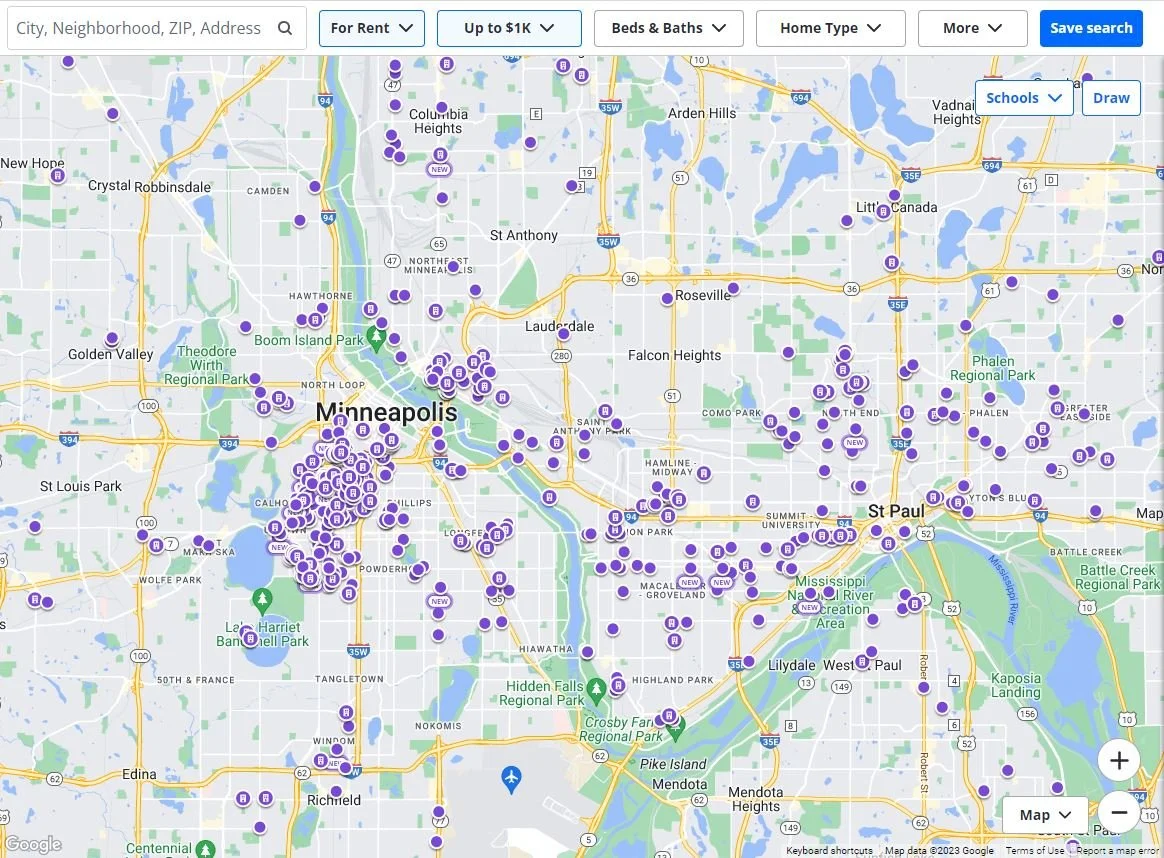One of the best things about the globally-connected world in which we live is that stories and ideas can spread incredibly quickly. Thanks to the internet, I have learned so much about housing from the experiences of people all over, for example, residents of the city of San Francisco.
One of the worst things about the globally-connected world in which we live is that stories and ideas can spread incredibly quickly. Thanks to the internet, I have tried and failed to forget so much about housing from the experiences of people all over, for example, residents of San Francisco.
But whatever I might read on my feed, whether inspiring or infuriating, it remains a fact that I do not live in San Francisco. Instead, I live in Minneapolis. If I want to stop learning about San Francisco, I have the merciful option of logging off.
I hope this fact is obvious. And yet sometimes when it comes to discussing housing policy I find myself having to insist that Minneapolis is not San Francisco. Nor is it Los Angeles, New York City, Boston, Philadelphia, Washington DC, Cleveland, Austin, Denver, Boise, Portland, or Seattle. It is more like some of these cities than others, but it is not any of them. You can see parallels and make comparisons, but something you can’t do is enact a policy in one city and get the same result that you would get if you enacted it in Minneapolis.
The Case Of the Missing Triplexes
In the pages of Streets.mn, Zak Yudhishthu recently wrote a nice summary of the state of accessory dwelling unit (ADU) construction in the Twin Cities. Both Minneapolis and St. Paul legalized these structures with some fanfare in the past decade. Many cities in the United States, especially in California, have seen an ADU building boom after local and state laws permitted and streamlined their construction. But in the Twin Cities, this has not occurred. Yudhishthu found that just 27 permits had been pulled (and not subsequently withdrawn) for ADUs in the capital city. A recent article in the Star Tribune found that fewer than 200 ADUs had been constructed in a decade in Minneapolis.
Yudhishthu’s research is a nice complement to numbers that I pulled last year on the construction of small multifamily structures in the two core cities. Between January 2010 and February 2023 (the last month for which we have data as of this writing) permits have been pulled for a total of 435 units in two-to four-unit buildings. In 2022 alone, a grand total of 10 duplexes, 11 triplexes, and five fourplexes started construction, for a net of 73 new units.
Construction of ADUs and small multi-family buildings in Minneapolis and St. Paul adds supply comparable to constructing one additional building like this one every year. (Credit: Lander Group)
These numbers are not nothing. Together, they are roughly equivalent to a single extra 2320 Colfax per year. Which is great! Over 500 households are housed in these ADUs and small multifamily buildings. Many of these units would not exist without the progressive land use policies passed in the past decade in both Twin Cities. It seems safe to say that there are some people who are only housed today because of the units were built.
But what these policies did not do was solve the region’s housing issues in a single stroke. Nor did they completely transform the cities in which they were enacted. Neither pollyannaish expectations of a zoning revolution nor hyperventilating predictions of bulldozed neighborhoods came to pass. What happened to development patterns in Minneapolis was that they didn't change much from what was occurring before these policies were passed (just with a few extra units in some old fashioned building types made new again).
But if you had passed the same policies somewhere else, for example coastal California, would the development response have been similarly muted?
Not necessarily! Those other places are different!
The Case Of The Too-High Rent
Zillow results from the San Francisco Bay Area. Every purple dot represents an apartment available for less than $1,000/mo.
Recently I embarked upon a simple exercise. I went to Zillow.com and looked for apartments that rented for under $1,000 per month. I found 7 listings in the San Francisco Bay Area, 27 listings in Greater Los Angeles, 71 listings in Metro Phoenix, and 509 listings in the Twin Cities.
Zillow results from the Twin Cities. Every purple dot represents an apartment available for less than $1,000/mo.
Now, there are some interesting wrinkles that complicate a plain interpretation of this exercise. For example, the Twin Cities have a large number of small two-to-four-story buildings with studio and one-bedroom units. Many of these are of prewar construction and not especially up to date. These attributes, which do not compromise their habitability, also make them extremely affordable. In contrast, a city like Phoenix, which has boomed only in the past 50 years, has few buildings like these and is at an inherent disadvantage when it comes to having units that meet my parameters. It can’t be ruled out that other cities have homes of other styles that are nevertheless cheap relative to their type.
But, sufficiently caveated, I think you can still say with confidence that the Twin Cities are much more affordable than many other peer cities. To at least some degree, this manifests itself at every level of the housing market. As a general rule, renters and homeowners in the Twin Cities get good value for the money they spend on housing.
This is a good thing. Broad affordability is a policy success. The Twin Cities region is doing some things right. People have more money in their pockets for non-housing purchases and less stress in their lives over housing payments. Fewer people are sleeping in cars or in tents than might otherwise, because housing in the Twin Cities is relatively affordable.
This does not mean that nobody in the region is living paycheck to paycheck. It does not mean that nobody is sleeping outside. It does not mean that every policy passed in the region is a good one. Far too many people are housing insecure and there’s no reason to spike the football and declare victory. You could still describe the situation in the Twin Cities as an ongoing urban housing crisis.
But many American cities are facing an urban housing crisis. Is the Twin Cities facing an urban housing crisis to the same degree that other cities are facing an urban housing crisis?
Not necessarily! Those other places are different!
Calibrating Rhetoric and Remedy With Reality
If this point seems obvious when stated so directly, it is nevertheless often lost in the discourse about housing problems (and sometimes other urban issues).
To take the two broad examples of policy areas mentioned in the preceding sections:
People might notice that Minneapolis hasn’t seen a building spree after the passage of the nationally-heralded 2040 Plan and conclude that it is not useful to rezone single family areas for duplexes and triplexes in their city. But this conclusion would depend on how similar their city’s housing market is to the housing market in Minneapolis. If the two are dissimilar, any prediction about the effects of similar policy must be calibrated to this difference.
Or in another sense, people might see that plenty of housing supply is being built in high cost cities with strict rent regulations, so they might argue that the negative effects of such a policy are likely to be negligible in a city like St. Paul. But for this to be true, prospective rents in St. Paul would need to have a similar relationship to the cost of construction than in these higher cost comparisons. If this is not the case, results are likely to surprise.
The scale of the housing cost issue in coastal states, especially California, has put a spotlight on the issue nationally, which is a good thing. There are so many great ideas and insights about how to make housing more affordable and how to build more affordable housing, because a ton of smart people are thinking about them.
But this ‘Californization’ of the housing issue has also made it difficult to discuss the ways in which local conditions may vary. Some discretion is required. It’s useful to establish values and principles (“we should build more housing of many different types”) on as broad a basis as possible. However, applying them at smaller geographies requires local knowledge and nuance before the sloganeering starts.
Drilling down to some specific policies recently passed elsewhere :
California is preempting local zoning and mandating more intense zoning around transit stations. This is a great policy that would be virtually useless in Minnesota, where there isn’t a big network of underutilized commuter rail stations and where suburbs are remarkably TOD friendly. But it would be a great policy in Pennsylvania!
Pennsylvania is providing grants to property owners and renters to fix issues that, once addressed, can unlock a lot more federal money for weatherization. This is a great policy that would be extremely useful in Minnesota, where there are enough old homes that require attention and the need for weatherization is acute. But it wouldn’t be as important in California!
Last year I wrote about myths surrounding the Minneapolis 2040 Plan and how the version of the plan that exists in the popular consciousness has outstripped the reality of the plan on the ground. As ideas spread on social media, they lose their context in place and time. Something that started out as radical may seem pedestrian in another time and place. Or vice versa; something incremental in one city may appear dramatic in a different one. As best as we can, we should try to research and reapply this context before polemicizing.


